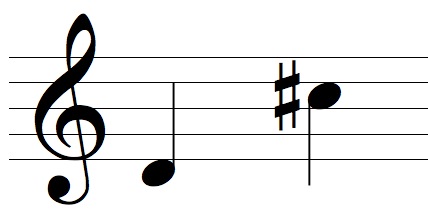7ths – Ear Training Chord
In this lesson you will hear either a Major or Minor 7th played as a chord and try to identify it.
When played as a chord, the strong dissonance of the Major 7th chord is much more noticeable.
When played as a chord, the strong dissonance of the Major 7th chord is much more noticeable.
7ths – Ear Training Down
In this lesson you will hear either a Major or Minor 7th played descending and try to identify it.
A Major 7th, is considered a strong dissonance, while a Minor 7th is considered a weak dissonance.
Try to use the "completing the melody" strategy to tell the difference.
A Major 7th, is considered a strong dissonance, while a Minor 7th is considered a weak dissonance.
Try to use the "completing the melody" strategy to tell the difference.
7ths – Ear Training Up
In this lesson you will hear either a Major or Minor 7th played ascending and try to identify it.
A Major 7th, is considered a strong dissonance, while a Minor 7th is considered a weak dissonance.
Try to use the "completing the melody" strategy to tell the difference.
A Major 7th, is considered a strong dissonance, while a Minor 7th is considered a weak dissonance.
Try to use the "completing the melody" strategy to tell the difference.
7ths – Reading Music
In the next set of lessons, we will review what we know about Major and Minor 7ths.
| Interval | Semitones | Example | Minor 7th | 10 | C Bb | Major 7th | 11 | C B |
Please press the Exercise button below.
Major 7ths Playing By Ear Chord
In this lesson, you will hear Major 7ths played as chords, then play them on your instrument.
A Major 7th is considered a strong dissonance because of it's rough sound.
A Major 7th is considered a strong dissonance because of it's rough sound.
Major 7ths Playing By Ear Down
In this lesson you will hear Major 7ths played downwards, then try to play them on your instrument.
Major 7ths Playing By Ear Up
In this lesson, you will hear Major 7ths played upwards, then play them on your instrument.
Major 7ths Writing by Name
In this lesson, you will write Major 7ths in music notation, but this time without the aid of an instrument.


The easiest way to write a Major 7th is to find the octave, then go down a half step.
Major 7ths Writing With Instrument
In this lesson, a Major 7th will be shown on your instrument, then you will write it in music notation.
Always make sure that you are spelling it as a Major 7th, and not a Diminished Octave.
A Diminished Octave should stick out like a sore thumb because the top and bottom note use the same letter.
Always make sure that you are spelling it as a Major 7th, and not a Diminished Octave.
A Diminished Octave should stick out like a sore thumb because the top and bottom note use the same letter.